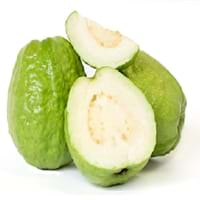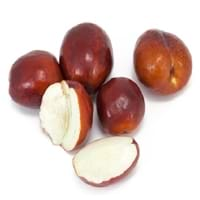Health Benefits
Cancer prevention, Diarrhea treatment, Prevents constipation, Scurvy treatment, Treatment of dysentary
Cancer prevention, Diarrhea treatment, Improves muscular strength, Liver health, Maintains hormonal balance, Reduces nervous tension, Reduces blood circulation problems, Reduces stress, Regulation of heart rate, Treatment of hysteria
General Benefits
Controls blood pressure, Cures cough, Improves eye vision, Maintains healthy cholesterol level, Treatment of common cold
Anti oxidant properties, Digestive aid, Flu treatment, Helps in weight loss, Strengthens bones, Treatment of common cold
Skin Benefits
Anti-aging benefits, Brightens and lightens complexion, Hydrates skin, Treatment of skin diseases
Heals sunburn, Hydrates skin, Reduces wrinkles, Skin rejuvenation, Skin revitalization
Hair Benefits
Prevents hair loss
Promotes longer and healthier hair, Protects hair
Allergy Symptoms
Breathing difficulty, Coughing, Runny nose, Sneezing, Swelling of mouth, tongue or lips, Wheezing
Abdominal pains, Breathing difficulty, Diarrhea, Hives, Itching in eyes, Itching of nose, Nasal congestion, Redness of eyes, Runny nose, Sneezing, Wheezing
Side Effects
Hair thinning, Nail thinning, Skin problems, Tooth decay, Weakness, Possibly unsafe during pregnancy
Decrease in blood sugar levels, Intense headache
Lactating Women
Yes
Not Available
Best Time to Eat
As a snack in the late afternoon, Don't consume at night and before bed, Eat the fresh ones, avoid mixing with any other foods, don't eat after meal., Morning time (before lunch)
As a snack in the late afternoon, Don't consume at night and before bed, Morning time (before lunch), Strictly avoid empty stomach
Vitamin B5 (Pantothenic Acid)
Not Available
Vitamin B9 (Folic acid)
Not Available
Vitamin C (Ascorbic Acid)
Vitamin E (Tocopherole)
Not Available
Vitamin K (Phyllochinone)
Not Available
Lutein+Zeaxanthin
Not Available
Calories in Fresh Fruit with Peel
Calories in Fresh Fruit without Peel
Not Available
Not Available
Calories in Frozen Form
Not Available
Not Available
Calories in Canned Form
Not Available
Calories in Juice
Not Available
Calories in Jam
Not Available
Calories in Pie
Not Available
Type
Tree fruit, Tropical
Tree fruit
Season
All seasons
Autumn, Summer
Varieties
Lucknow 49, Allahabad Safeda, Chittidar, Harijha, Apple guava, Hafshi, Arka Mridula and Allahabad Surkha
Honey Jar, Sugar Cane, Li, Shanxi Li, Sherwood, Chico, Silverhill, Tigertooth, Winter Delight and Lang
Color
Green, Pink, Yellow
Green, Red, Yellow
Origin
Central America, Mexico, South America
Syria
Soil Type
Loam, Rocky, Sandy
Sandy, Well-drained
Climatic Conditions
Sunny
Warm to hot climate
Facts about
- The black pigment in Guava leaves is used for textile applications.
- Guava leaves are used to make tea.
- Oils extracted from guava seeds are used in various cosmetics.
- Guava wood is used for decorative purposes.
- Pigment extracted from Indian jujube is used for silk dyeing in Burma.
- In Korea, jujube wood is used to make wind instrument taepyeongso.
- Fresh jujube is known as Chinese apple & dried form is called as Chinese date.
Other Countries
China, Indonesia, Mexico, Nigeria, Pakistan, Philippines, Thailand
Bangladesh, India, Iran, Korea, Lebanon, Pakistan
Top Importer
Canada
United States of America
Botanical Name
Psidium guajava
Ziziphus zizyphus
Synonym
Not Available
Ziziphus jujuba or Ziziphus mauritania or Zizyphus jujuba
Subkingdom
Tracheobionta
Tracheobionta
Division
Magnoliophyta
Magnoliophyta
Class
Magnoliopsida
Magnoliopsida
Family
Myrtaceae
Rhamnaceae
Species
Psidium guajava
Z. zizyphus
Generic Group
Myrtle
Not Available
Difference Between Guava and Jujube
We might think that Guava and Jujube are similar with respect to nutritional value and health benefits. But the nutrient content of both fruits is different. Guava and Jujube Facts such as their taste, shape, color, and size are also distinct. The difference between Guava and Jujube is explained here.
The amount of calories in 100 gm of fresh Guava and Jujube with peel is 68.00 kcal and 79.00 kcal and the amount of calories without peel is Not Available and Not Available respectively. Thus, Guava and Jujube belong to Low Calorie Fruits and High Calorie Fruits category.These fruits might or might not differ with respect to their scientific classification. The order of Guava and Jujube is Myrtales and Rosales respectively. Guava belongs to Myrtaceae family and Jujube belongs to Rhamnaceae family. Guava belongs to Psidium genus of Psidium guajava species and Jujube belongs to Ziziphus genus of Z. zizyphus species. Beings plants, both fruits belong to Plantae Kingdom.









